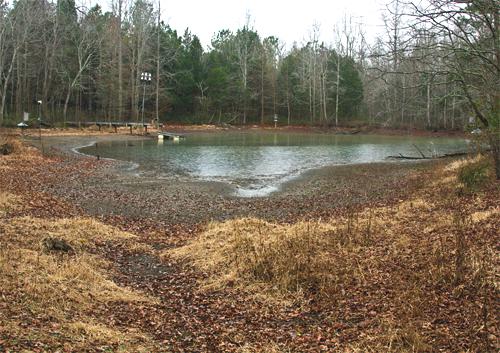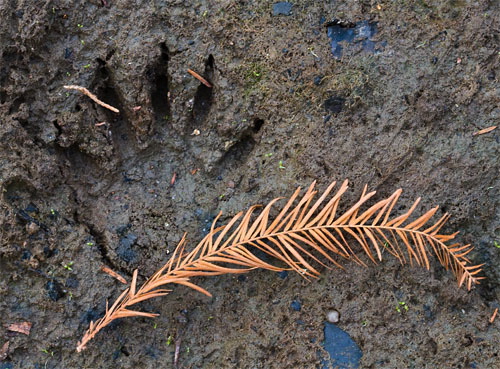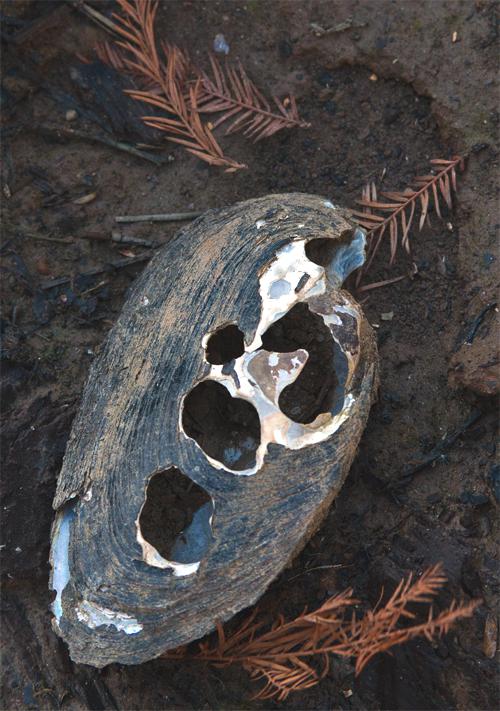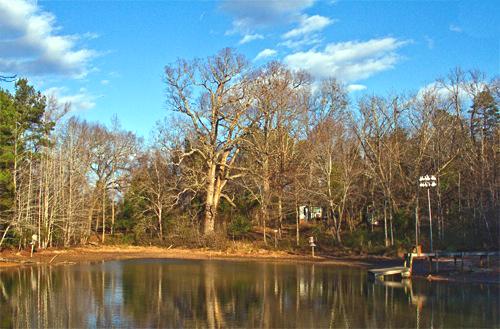|
HOME: www.hiltonpond.org |
|||
THIS WEEK at HILTON POND (Back to Preceding Week; on to Next Week) |
•TROPICAL HUMMINGBIRD EXPEDITIONS• We're now enrolling for Costa Rica East & Guatemala (both Nov 2013). (Click on logo above for itineraries & trip details.)
|
THE SHRINKING POND: Last week's photo essay was about our most recent Operation RubyThroat hummingbird expedition to warm, sunny Costa Rica and included all sorts of colorful images of Neotropical birds and orchids. Now that it's December and we're back home at Hilton Pond Center, things are more subdued as weather cools and local flora and fauna become less active. Winter's on the way--it arrives officially the morning of 21 December--but despite the chill there are still plenty of things to see on our 11-acre spread in the heart of the Carolina Piedmont. Some are everyday phenomena, of course, but that doesn't make them any less interesting to watch, ponder, and photograph. This week, in fact, we've been observing effects of our on-going drought, fervently hoping rain soon will bring much-needed relief to aquatic organisms getting more and more crowded as Hilton Pond grows smaller by the day.
All text, maps & photos © Hilton Pond Center We've been talking for months about our lack of rain here at the Center, where Hilton Pond has "bottomed out." Well, at least that's what happened to a float designed to sit level with the pier when our one-acre impoundment is at full pond. Right now the float is mired in mud at the end of the pier (see images above and below)--about four feet below where it's supposed to be floating. Normally, the Wood Duck boxes around the pond perimeter stand in three feet of water that helps protect them from various predators; fortunately, cone-shaped metal predator guards also serve that function--now that Raccoons, Virginia Opossums, Black Ratsnakes, and other egg- and duck-eaters will be able to walk or slither across mud flats to get to poles upon which the boxes are mounted.
All text, maps & photos © Hilton Pond Center One windless day this week we gazed out our office window at the diminishing pond and saw what looked like a yellow sheen on its surface. We first thought catkins of Hazel Alder shrubs growing on the bank had opened particularly early this year and guessed the sheen was from billions of pollen grains. When we investigated more closely, however, we discovered the male catkins wouldn't be open for at least another fortnight and that the yellowish surface was actually multicolored--a "rainbow" similar to what one finds under cars after a rain. Unlike what might be seen in a parking lot, this suspicious sheen on Hilton Pond wasn't from motor oil but from natural compounds released as newly exposed organic matter on the bottom decomposes. If we don't get some rain soon, there may be a lot more decomposition while waters get shallower and shallower. (NOTE: We often hear from folks that a neighborhood stream or pond has been contaminated by an oil spill, as indicated by a rainbow sheen. On still or slow-moving water the situation more often than not is just what we've described: A natural breakdown of organic matter--especially leaves from trees overhead.) Unlike many Piedmont ponds, ours isn't fed by a reliable spring or creek; its only water source is direct rainfall and accompanying run-off--both of which have been sadly lacking in recent seasons. Drought effects are worsened by our letting trees, shrubs, and herbaceous plants grow on the banks of Hilton Pond; their roots take up water from the pond and send it skyward. That doesn't mean we regret the vegetation--which came in as part of natural succession--and we certainly won't be cutting it all down despite the transpiration effect.
All text, maps & photos © Hilton Pond Center Although WE haven't cut many trees around the impoundment, a few dead ones have fallen into Hilton Pond and another is very close to toppling. The one above is a Sweetgum that obviously is no longer alive--as shown by the thriving colony of white bracket fungus on its trunk. Most bracket fungi in these parts grow on dead wood--a few are parasitic--so you might suspect the Sweetgum has been dead for at least a few years. What killed it is obvious if you look at the lower 18" of the trunk: A complete lack of bark due to an industrious American Beaver that paid us a visit back in early 2008. The beaver chewed several saplings on the north side of the pond--selecting primarily Sweetgums whose sap must be (as the name suggests) pretty tasty. This buck-toothed rodent stayed around for a few weeks before promptly disappearing and we haven't seen one since. Although we enjoy our diversity of wildlife, it's good the beaver has gone; an ever-smaller one-acre impoundment on an 11-acre tract with limited trees is hardly big enough habitat to accommodate an active beaver colony. Nonetheless, it's interesting the last of the trees de-barked by our former beaver is still standing after four years.
All text, maps & photos © Hilton Pond Center Raccoons are a whole 'nother matter around Hilton Pond Center. These masked mammals are a constant nocturnal presence, although their numbers fluctuate considerably year to year and season to season. There were so many 'coons this spring we had to start bringing all our feeders in each evening--and we do mean ALL, including those containing sunflower seed, cracked corn, thistle, or sugar water. Leave 'em out and the 'coons would climb the support poles to eat all the seed and drain our hummer feeders overnight. For some reason our local Raccoons seem less interested in feeder-robbing this fall, but we know the bandits are out there--as shown by dozens of tracks in soft mud around the edges of Hilton Pond. It's interesting how 'Raccoons seem to be the only critters leaving footprints like the one above, shown with a Bald Cypress leaf. It may be the mud is so mushy a cloven-hoofed White-tailed Deer would get bogged down--and to our knowledge the local Coyote clan that as of late has been howling from adjoining fields hasn't yet wandered in to drink a little pond water.
All text, maps & photos © Hilton Pond Center So what do Raccoons eat when they're not snacking on sunflower seeds or hummer juice? Perhaps freshwater mollusks we sometimes find buried in that same mud that bears 'coon footprints. One mollusk we've identified is Eastern Elliptio, Elliptio complanata, a freshwater mussel common in ponds and slow-moving streams across the eastern U.S. and Canada. Confronted by danger, this bivalve clamps its two shells so tightly shut almost nothing can get inside, but when the mussel is stressed a 'coon might get a canine tooth between the shell lips far enough to pry the thing open for a succulent snack. In the case of the recently exposed mussel shells above, however, we doubt a Raccoon made the round holes; these are, in fact, a bit of a mystery. Perhaps a rodent of some sort was getting its daily mineral supplement by gnawing on the mollusk's calcium-rich shell. (If you have an alternate explantion, please let us know via e-mail at RESEARCH. In a marine habitat we would have pointed the finger at something like an Oyster Drill, a predatory univalve that goes after saltwater bivalves by rasping through their shells. And, since the shell has been on the bottom of the pond untouched by human hands, we're pretty certain the holes are NOT from button cut-outs--even though Elliptio shells were once used for such things.)
All text, maps & photos © Hilton Pond Center Low water levels probably do make Eastern Elliptios--and tadpoles and salamanders and fingerling fish--more vulnerable to predators and the elements. Maybe one GOOD thing about a shrinking Hilton Pond is long-submerged stumps have become available as sunning spots for half-grown Yellowbelly Sliders (above)--active nearly year-round in our temperate Piedmont climate. Because water levels are rarely so low, this year is only the second time the stump in the photo has been exposed since we moved to the property in 1982. This particular stump, by the way, is the remnant of a tree cut at least 50 years ago--something we deduce because we know the pond was constructed about 1955 by the U.S. Soil & Water Conservation Service. (Ironically, Hilton Pond and another larger impoundment into which it flows were installed, in part, to retard erosion arising from heavy rains--something we obviously haven't had to contend with lately.) By the way, how many sliders do you see atop the exposed stump? (Look carefully at the "one" on the left; no, it doesn't have two heads! There are actually five turtles altogether--a nice assemblage for a coolish but sunny day during the first half of December.)
All text, maps & photos © Hilton Pond Center The photo just above was made back in mid-November 2004, when Hilton Pond was about as full as it could get without flowing over its dam; the one below was taken this week from the same spot after all the leaves had fallen. It will take an awful lot of rain this winter to bring our impoundment back to the 2004 level, but we can always hope. That said, whatever happens, happens; there's not much we can do about the weather or the resulting ever-lower levels on our pond. As we've said before, just as old fields eventually become woodlands via natural succession, so will a pond eventually turn to marsh, then meadow, and finally to forest. We won't be around long enough to see the latter, of course, but we do wish our pond would dry up a little more slowly. "This Week at Hilton Bog" just doesn't have quite the same ring.
All text, maps & photos © Hilton Pond Center POSTSCRIPT: After we published the above photo essay we also posted an inquiry to the MOLLUSCA listserve concerning unusual roundish holes in that Eastern Elliptio shell exposed by low water levels. We got several interesting responses, including the following from David Campbell: "The holes as presently visible are from chemical erosion. Calcium carbonate (as aragonite) in the shell is readily dissolved by acid such as from decaying plant material. Ray Kinney also contributed this explantion: "I have some experience with shell degradation in low calcium environments in western Oregon (Margaritifera falcata). Here, living mussel shells that have exposed calcium around the umbo region begin to dissolve slowly during buffering challenge events (heavy rain events, snowmelt events, and anthropogenic acidification pressure events). Our low exchangeable calcium levels in the water (6 to 18 mg/l calcium carbonate) tends to dissolve any readily available source of calcium (the exposed shell) as the water gets buffered a bit. Often living mussels will become perforated, bringing premature mortality of all age classes. A mort mussel shell will dissolve entirely in only about eight months to a year, leaving just some of the periostracum. Your mussel shell appears to me to have been subject to similar exterior dissolution that has spread beyond just the umbo region. Where the shell becomes very thinned, it is also very much weakened. Any force could punch holes through (e.g., Raccoon bite), or snails could have been grazing on all of this high quality calcium that is readily available. Extensive dissolution could have even perforated the shell, but likely some external force broke through the weakened shell. Based on tests conducted by various college classes, the waters of Hilton Pond have always been a bit acidic. With increased decomposition and a reduction in water volume, we do suspect the acidity has gone high enough to create holes in the Elliptio shell. Thanks to David, Ray, and other MOLLUSCA subscribers who offered this explantion. All end-of-year contributions are tax-deductible on your |
|---|
 The Piedmont Naturalist, Volume 1 (1986)--long out-of-print--has been re-published by author Bill Hilton Jr. as an e-Book downloadable to read on your iPad, iPhone, Nook, Kindle, or desktop computer. Click on the image at left for information about ordering. All proceeds benefit education, research, and conservation work of Hilton Pond Center for Piedmont Natural History. The Piedmont Naturalist, Volume 1 (1986)--long out-of-print--has been re-published by author Bill Hilton Jr. as an e-Book downloadable to read on your iPad, iPhone, Nook, Kindle, or desktop computer. Click on the image at left for information about ordering. All proceeds benefit education, research, and conservation work of Hilton Pond Center for Piedmont Natural History. |
|
|
"This Week at Hilton Pond" is written and photographed by Bill Hilton Jr., executive director of Hilton Pond Center for Piedmont Natural History
|
|
|
Please refer "This Week at Hilton Pond" to others by clicking on this button: |
Comments or questions about this week's installment? Send an E-mail to INFO. (Be sure to scroll down for a tally of birds banded/recaptured during the period, plus other nature notes.) |

Click on image at right for live Web cam of Hilton Pond,
plus daily weather summary
Transmission of weather data from Hilton Pond Center via WeatherSnoop for Mac.
|
--SEARCH OUR SITE-- For a free on-line subscription to "This Week at Hilton Pond," send us an |
|
Thanks to the following fine folks for recent gifts in support of Hilton Pond Center for Piedmont Natural History and/or Operation RubyThroat: The Hummingbird Project. Your tax-deductible contributions allow us to continue writing, photographing, and sharing "This Week at Hilton Pond" with students, teachers, and the general public. Please see Support or look below if you'd like to make an end-of-year tax-deductible gift of your own.
|
If you enjoy "This Week at Hilton Pond," please help support Hilton Pond Center for Piedmont Natural History. It's painless, and YOU can make a difference! (Just CLICK on a logo below or send a check if you like; see Support for address.) |
|
Make credit card donations on-line via Network for Good: |
|
Use your PayPal account to make direct donations: |
|
If you like shopping on-line please become a member of iGive, through which 950+ on-line stores from Amazon to Lands' End and even iTunes donate a percentage of your purchase price to support Hilton Pond Center.  Every new member who registers with iGive and makes a purchase through them earns an ADDITIONAL $5 for the Center. You can even do Web searches through iGive and earn a penny per search--sometimes TWO--for the cause! Please enroll by going to the iGive Web site. It's a painless, important way for YOU to support our on-going work in conservation, education, and research. Add the iGive Toolbar to your browser and register Operation RubyThroat as your preferred charity to make it even easier to help Hilton Pond Center when you shop. Every new member who registers with iGive and makes a purchase through them earns an ADDITIONAL $5 for the Center. You can even do Web searches through iGive and earn a penny per search--sometimes TWO--for the cause! Please enroll by going to the iGive Web site. It's a painless, important way for YOU to support our on-going work in conservation, education, and research. Add the iGive Toolbar to your browser and register Operation RubyThroat as your preferred charity to make it even easier to help Hilton Pond Center when you shop. |
|
BIRDS BANDED THIS WEEK at HILTON POND CENTER 1-15 December 2012 |
|
|
SPECIES BANDED THIS WEEK: * = New species for 2012 WEEKLY BANDING TOTAL: 2 species 6 individuals 2012 BANDING TOTAL: 31-YEAR BANDING GRAND TOTAL: (since 28 June 1982, during which time 171 species have been observed on or over the property) 126 species (31-yr avg = 67.3) 58,110 individuals (31-yr avg = 1,875) NOTABLE RECAPTURES THIS WEEK:
|
OTHER NATURE NOTES: --If you missed last week's photo essay it was a summary report--complete with lots of photos--of our latest successful hummingbird expedition to eastern Costa Rica. See Installment #556. All text & photos © Hilton Pond Center |













 Oct 15 to Mar 15:
Oct 15 to Mar 15: